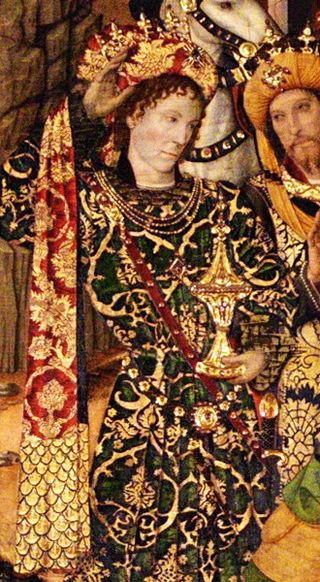Top Qs
Timeline
Chat
Perspective
Peter, Constable of Portugal
Constable of Portugal From Wikipedia, the free encyclopedia
Remove ads
Peter of Coimbra (also known as Peter the Constable) (Portuguese: Pedro, pronounced [ˈpeðɾu]; c. 1429 – Granollers, 30 June 1466), sometimes known as Peter V of Aragon or the Intruder King (el Rey Intruso),[1][2] was the son of Infante Peter, Duke of Coimbra, who became the fifth Constable of Portugal and third Grand Master of the Order of Saint Benedict of Aviz. The Consell de Cent later granted Peter the Crown of Aragon, which he claimed from 1463 to 1466 in opposition to John II. His status as king of Aragon, however, along with that of John II's other challengers, is disputed.
Remove ads
Early life and background
Peter was the eldest son of Infante Peter, Duke of Coimbra and Isabella of Urgell.[3] His father served as regent of the Kingdom of Portugal for Afonso V between 1439 and 1448.[1]
Peter inherited a claim to the Aragonese throne through his maternal grandfather James II, Count of Urgell, who was the last male descendant of the House of Barcelona and heir to the Crown of Aragon by the rights of agnatic primogeniture.
Remove ads
Maturity
Summarize
Perspective
In 1443, after the death of his cousin Infante Diogo and by the instigation of his father, Peter was elected the Constable of Portugal, enraging Afonso, Marquis of Valença, the son of his half-uncle Afonso, 1st Duke of Braganza, who believed the title was rightfully his.[4] This political move, along with Afonso V's marriage to Isabella of Coimbra, Peter's sister, instead of the granddaughter of the Duke of Braganza, caused significant conflict between the two parties.[4][5] In the same year, after the death of his uncle Ferdinand, Peter was granted the mastership of the order of Avis.[4]
In 1448, when King Afonso V of Portugal became of age and took reign, the Duke of Coimbra stepped down as regent. Afonso V, because of influence of the Duke of Braganza, who became the political enemy of Peter's father, voided all laws created under Coimbra's regency. Peter was stripped of both the constableship and the master of Avis.[6] Intense disagreement and intrigue led to the Battle of Alfarrobeira, culminating in the death of Pedro and the exile of his children.[7] Unlike his siblings, who went to the court of their aunt Isabella in Burgundy, Peter fled to Castile.[1]
Peter's exile in Castile constitutes the main period of his activity as a writer.[1] Described as a disciple of Rodríguez del Padrón, he completed two projects, Satira de Infelice e Felice Vida and Tragédia de la insigne reina doña Isabel.[8] The works are considered some of the earliest examples of sentimental fiction.[9]
In 1456 or 1457, Peter reconciled with King Afonso V and the Duke of Braganza, thus allowing him to return to Portugal and reclaim all his family's previous possessions.[2][6] Upon his return, he participated in several of Afonso's expeditions to northern Africa.[1][2]
Remove ads
King of Aragon
In 1463, the Catalan institutions, which were in civil war with John II of Aragon, offered their crown to Peter.[10] He was crowned King of Aragon, Count of Barcelona, and King of Valencia by the Consell de Cent. He reigned de facto in the Principality of Catalonia and parts of the Kingdom of Aragon, but only de jure in Valencia, which was occupied by John II of Aragon. The territory under his control only included Barcelona, most of Catalonia and parts of Aragon.[citation needed]
With the support of his aunt Isabella, Duchess of Burgundy he became engaged to Margaret of York, sending her an engagement ring and a marriage contract.[citation needed] Margaret would later marry Isabella's son Charles the Bold.
Death

After a period of ineffectual rulership, Peter died in 1466 of natural causes.[1][11] He is buried in Church of Santa Maria del Mar in Barcelona, Catalonia. After his death, the Catalans offered the crown to René of Anjou.[12]
Ancestry
Remove ads
Citations
Sources
External links
Wikiwand - on
Seamless Wikipedia browsing. On steroids.
Remove ads

